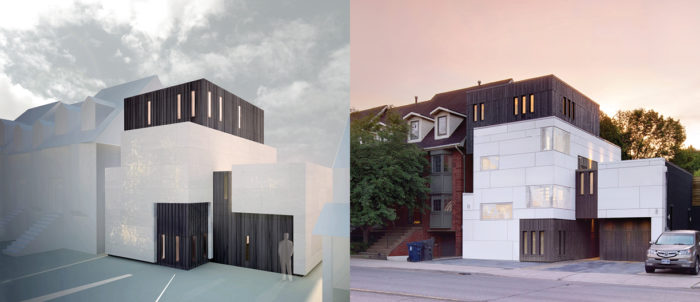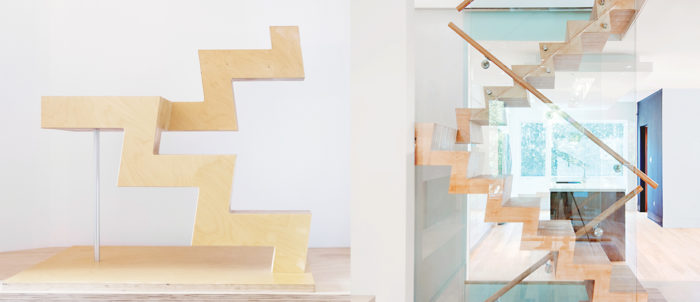We believe that the best design is grounded in dialogue. Through getting to know one another, we are able to create honest, beautiful spaces together. So let’s talk.
In Conversation
Why You Only Think You Want What You Want
Daniel Harland and Gary Westwood talk client expectations, the design-build dance, and why no one actually enjoys choosing grout.
Don’t get Daniel Harland started about camels. Although he does know a thing or two about them. Years before he launched Roundabout Studio with Gary Westwood in 2003, Harland studied zoology before eventually landing at OCAD in Toronto.
“My father is a carpenter and my uncle is an architect, so I kind of grew up around it,” says Harland, the studio’s design director. His father encouraged him to consider other lines of work as well, but the experiment didn’t stick.
“You have to be really dedicated to a specific thing,” he says of zoology. “People study penguins for 40 years. You go to the Antarctic for three months on your own. That’s not my thing.”
How fortunate. Now with more than 300 varied projects completed in Toronto and around Southern Ontario, Harland and managing director Westwood, who met while Westwood was guest lecturing at OCAD, are looking forward to the next 300. The pair sat down with Kira Vermond, journalist – and Roundabout client – to discuss their process, house style, and what truly makes a person feel connected to their home.
Our style is actually process-based and we create projects based on the relationships we have with our clients. They’re always going to be different.
- Daniel Harland
Kira Vermond: You once told me you have a similar approach to each project Roundabout works on, but the process can change dramatically. Why is that?
Gary Westwood: Each relationship, client and circumstance is so different. Everybody’s different.
Daniel Harland: Everybody. One client wants us to give him just one design option. And it better be good. And then another client wants to be so involved and invested that she is constantly sketching and getting Pinterest ideas. But there are a lot of people who are in-between. They want three or four options to choose from.

KV: That’s me. I want a few options about, say, cabinet hardware, but not too many. That’s exhausting.
DH: We’re thinking about those things all the time so it’s not that overwhelming for us. As for you, if you walked into a place with tile, there are 4,000 kinds of tile. How do you choose? I remember one time walking into a fabric shop with a client who was looking for upholstery for his couch. He walked in and he couldn’t stop laughing.
KV: Gary, you probably help in that department too. If design is all about blue sky thinking, you’re the one who brings a project solidly back down to earth. You give it parameters.
GW: Daniel will roll his eyes because he’s heard me say this many times before, but I actually do think that the contract is a form of communication. We can agree to change things or have things evolve. The contract is a mutual understanding of intent. And for me that’s very important so that we’re all on the same page from the beginning.
KV: I can see that. People are always asking us, “How’s your reno going?” and everybody expects us to moan, “Oh my gosh, our marriage is in trouble” or, “We’re exhausted.” But instead we’re saying, “We’re having a great time, actually.” I think that’s because of those communication touch points along the way. We also knew what direction we were all going in from the start.
GW: Right.
We don’t have all these rigid hierarchies that a larger firm would have, and it means clients aren’t passed along from person to person within a firm.
- Gary Westwood
KV: Let’s pivot. How did you envision Roundabout initially?
DH: Work, begets work. I think in the beginning it just evolved that way. I really love designing houses and it has become such an important part of what we do. But in the beginning I think we were probably expecting to do a mixture of public and private work. Size-wise though, we always wanted to be the size we are, so that hasn’t changed.
GW: Yeah, I like the vibe that having a certain number of people around you creates. It generates its own energy. We can broaden our toolkit in terms of skill sets. You know, some people are better at rendering. Some people are better at CAD. Some people have more experience in construction in residential houses and so forth. So I think it allows us to bring in a wider group of skills and attitudes, and yet we’re still at a size that’s personal. We don’t have all these rigid hierarchies that a larger firm would have, and it means clients aren’t passed along from person to person within a firm.
KV: And unlike some studios, Roundabout doesn’t have a so-called “house style.” Why not?
DH: Ultimately, we’ve always worked on things that are different and enjoyed that. Our style is actually process-based and we create projects based on the relationships we have with our clients. They’re always going to be different. I think we’ve finally recognized that, like, this is who we are.

KV: There’s got to be some upsides to working that way though.
DH: There’s an awful lot of benefit to it actually. It creates a diverse and interesting portfolio, and at the same time offers different avenues for people to realize their project dreams. We’re not just sculpting space. Eventually that space is for people.
KV: Is there a style that tends to pop up more often though?
DH: I think we stray toward comfortable modernism. But having said that, we’ve been asked to do Georgian houses. And we’ve been asked to do transitional-type places a fair bit. We’ve got a client right now that wants rigid minimalism.
GW: We still have to translate what homeowners want too. You know, people will frequently say “Oh I like Victorian houses.” But does that mean they like drafty rooms, poky living spaces and tiny kitchens? That probably isn’t what they really mean.
DH: It’s true. Building technology and materials certainly have changed, but then we also live totally differently. The kitchen is that great example. It went from a sort of back-of-house, servant-oriented type place to where it’s at now: the centre of the home. And that’s true of everything. Just think about Victorian houses and storage versus contemporary houses and storage.
KV: I once lived in Cabbagetown. Storage was horrible.
DH: Exactly. All of that has changed dramatically.
Questions about how you live are a part of our process. We’ll talk to you about family events and how many people show up. Do you eat here or there? Do you like to cook? Do you hate to cook? Those discussions yield a lot more than the simple brief about how to design.
- Daniel Harland
GW: Besides, I think if you attempted to make a Victorian house, it would look like someone tried – and failed.
DH: But what is it about those spaces that resonate for a client? Usually it’s something kind of nostalgic, to be honest. They loved their old floors, that window or that view.
I had a client once send us a picture of waves, seagulls and some people on the beach. He said, “We haven’t spoken about this yet, but this is the view that I’d like from my kitchen.” Their house was in Roncesvalles.
If you get to the root, you can give them a more fitting version for their house.

KV: Because you’re a design-build studio – although I know the majority of projects are design only – does the build side help inform your design?
DH: Your role in design is generally to expand expectations. The idea is to think about blue sky for a while, how you want to live and what you want to do to this space. Then construction is the opposite. You have to define – there’s going to be A, B or C. That’s it. No more or no less. Otherwise it gets out of hand. It’s weird doing both ends of it. You have to switch gears all along.
I grew up in renovated houses and we moved every two or three years. My father was always renovating them so I saw that. It doesn’t faze me at all. Most designers might not want to get involved in the build because it’s a very different process. But for me, I’m comfortable with it and I would rather control it and get what we want.
GW: Actually it’s funny, if I was to do another house for myself, of course I’d want to be involved in the process, but I would want it to have something that I could discover. I mean, not just show up like a house reno television show. Ta-da! Not that, but something buried that I could slowly discover over time. That would be an amazing thing.
DH: See? Everybody’s different. One of our clients, his life is very controlled. He’s in a hotel probably as much as he’s in that house. Another client’s life is about 40 people showing up for a party that evening and trashing one part of her house. I have kids. Those twisted and broken bits are actually kind of part of it.
These questions about how you live are a part of our process. We’ll talk to you about family events and how many people show up. Do you eat here or there? Do you like to cook? Do you hate to cook? Those discussions yield a lot more than the simple brief about how to design.
They’re about what’s important to you.